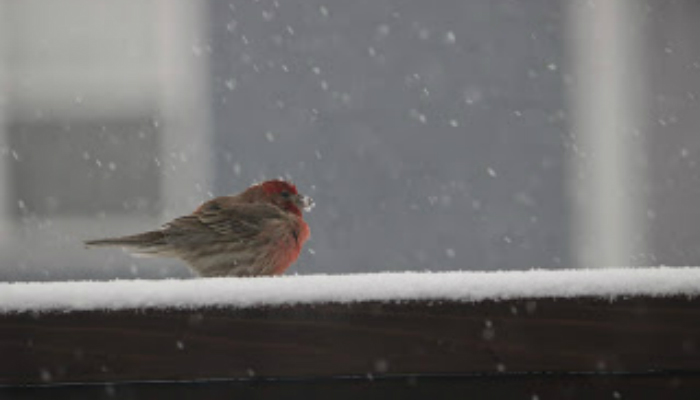Since I’m Looking Out the Window Anyway….

I haven’t participated in Project Feederwatch for the past several years. Since moving to a house in a new subdivision, the yard has been home to a depressingly small variety of birdlife: house sparrows and mourning doves, with some house finches and purple finches hanging around as well. Occasionally a few goldfinches or juncos wander through, and this morning saw an unusually inelegant Coopers hawk bumbling around the ground in the chicken-wire-fenced garden, trying to snatch an unfortunate sparrow that didn’t disappear quickly enough when the predator came into view.
Our previous house was in an older neighborhood, with huge old oak trees and established landscapes. Over an average winter weekend the backyard feeders could host a dozen or more bird species, from titmice and chickadees to three or four different varieties of woodpecker. There were house sparrows and mourning doves there too, but their numbers didn’t dominate the yard. It was fun to log so many different kinds of birds with Project Feederwatch, and note when I saw a record number of species or individuals of a particular species.
Now, at the new house, it was…less fun. Look, 10 house sparrows. No, 12. Now there are 17. Ooh, there’s a junco over in the neighbor’s yard…hop the fence so I can count you! Nope. Where are the house finches? Guess this weekend we saw 17 house sparrows and 3 mourning doves.
I know even boring data is important for science. In fact, boring data is probably incredibly important in establishing baseline data about populations and trends over the course of years or decades. So this year I decided to renew my participation Project Feederwatch for the low, low cost of $18. I will diligently log my house sparrows and mourning doves. No matter how dull the population of the backyard, I won’t cheat and count the crows that sometimes sip water out of the gutter on the front of the house—that’s outside the range of the feeders.
In time, as the neighborhood trees grow and mature, we will see more variety. We will get more cardinals and chickadees—I know they are in the area because I see them on neighborhood walks, just a couple blocks away where the houses are a decade older, the trees a few meters taller, and the birds feel more comfortable than in our wide-open expanses of turfgrass and baby trees. I will be able to watch the change in diversity: what once was dull cornfield, is now dull subdivision, but soon will be a (hopefully) more fully-formed ecosystem.
As the city changes—as houses pop up closer and closer to the Greenway, and streets are planned that will cut through the present-day isolation of the trail—nature changes along with it. Suitable habitat can become a wasteland, and wastelands in turn can become oases for wildlife with a little help from homeowners. Change is inevitable, and one thing we can do as observers is document the effect changes have on the smaller creatures who share our little patch of earth.
If you have a backyard feeder, consider joining Project Feederwatch this winter. It is a fun way to get to know the birds in your area (Cornell Lab offers many resources to help identify common feeder birds), and join a community of enthusiastic bird watchers helping contribute to science.
Originally published in Sycamore Greenway Friends.


